Is There a Best Wood For Beehives? Do The Bees Really Care?
Beekeeping is a fascinating, fun and rewarding hobby. However, when it comes to deciding what type of wood to use for your hives, the top pick is a hard decision. There’s a wide variety of options to consider before choosing a beehive.
The best wood for beehives is a good select grade premium pine. Pine lumber is easy to work with, it’s available everywhere in North America & Europe, and it’s the most affordable. Your pine bee boxes will last decades if properly treated and looked after.
When your new to beekeeping choosing the best wood for your shallows, mediums or brood boxes can be overwhelming. You have to consider your budget (beekeeping can be pretty expensive), availability of the lumber in your region, ease of use, and aesthetics.
What Is The Best Wood For Beehives

Of all the different woods used for bee boxes, Pine is most popular among hobbyists and large commercial operations. Pine lumber is readily available in all areas across North America and Europe. No matter your circumstances you’ll always be able to locate high quality Pine bee boxes.
If you’re on a tight budget, economy or commercial grade Pine is an inexpensive option for all new beekeepers and professionals alike. If you have a higher budget, you can purchase select or premium grade Pine woodenware.
Economy and commercial grade Pine will have minor cosmetic imperfections such as knots and the grain won’t be as straight. Whereas select or premium grade Pine will be defect free (knot free) and have a nicer looking straight grain.
It is important to paint or treat your Pine beehives. Pine, if left untreated, will rot very quickly when exposed to the elements and the boxes will begin to rot within 6 months to 1 year.

The 2nd most popular wood used for beehives is Cypress. Cypress is more expensive than premium Pine but some Beekeepers still swear by it. The other drawback is that it’s not widely available because Cypress trees are only found in the southern states of the US.
Cypress is a swamp lumber with a closed grain and works great in wet and high humidity regions. The sap (Cypressene) contained in Cypress is a natural preservative that assists in minimizing decay and repelling insects and mold.
Pro Tip: When purchasing Cypress bee boxes make sure the wood doesn’t contain 30+% of the material as sapwood. This type of wood is very prone to rot.
Some beekeepers will suggest not treating Cypress hives. While this was true when bee boxes were being made from old-growth Cypress, it is now not recommended since all Cypress boxes are made from new-growth (younger trees) Cypress.
Old-growth Cypress wood was known to last decades without treatment, but new-growth lumber will only last around 3 years. Now, most beekeepers apply some form of treatment (paint, stain, hot wax dip) to their Cypress wood beehives.
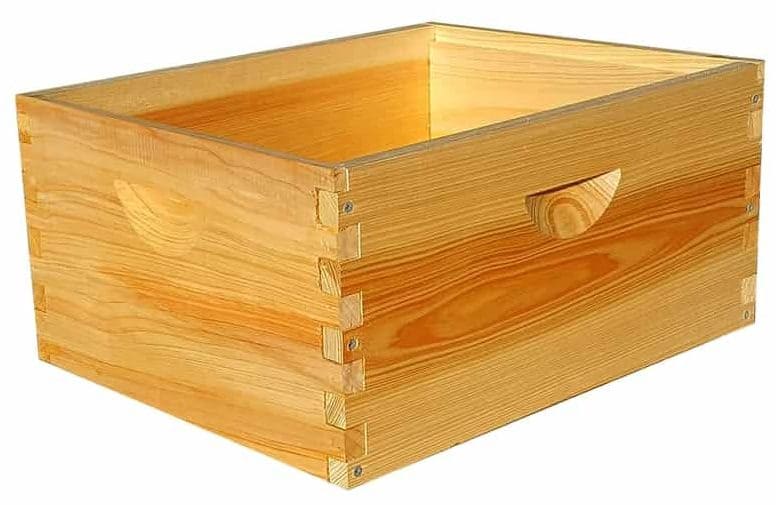
But what about Cedar for beehives? Well, they are among the most beautiful and aesthetically pleasing but are the most expensive and impractical.
Cedar hives are over double the cost of pine. For this reason, Cedar hives are never used in large scale commercial honey operations. But, like Cypress, some beekeepers really love using Cedar for their boxes.
Like Cypress wood, Cedar lumber contains natural oils that protect the wood from rotting and insects. You can use Cedar boxes untreated, but most beekeepers will treat their hives with Tung oil or something similar. Word of caution – Tung oil is not fun to work with and can be slow to dry.
Pro Tip: When purchasing Cedar boxes make sure and get Kiln Dried Cedar. This drying process reduces splitting in your Cedar.
Cedar is less likely to warp and has a wonderful smell, especially when it rains. But Cedar is more brittle and prone to splitting, especially when you’re constantly prying on the brood box with a hive tool.
But there is no doubt that Cedar makes a very beautiful beehive.
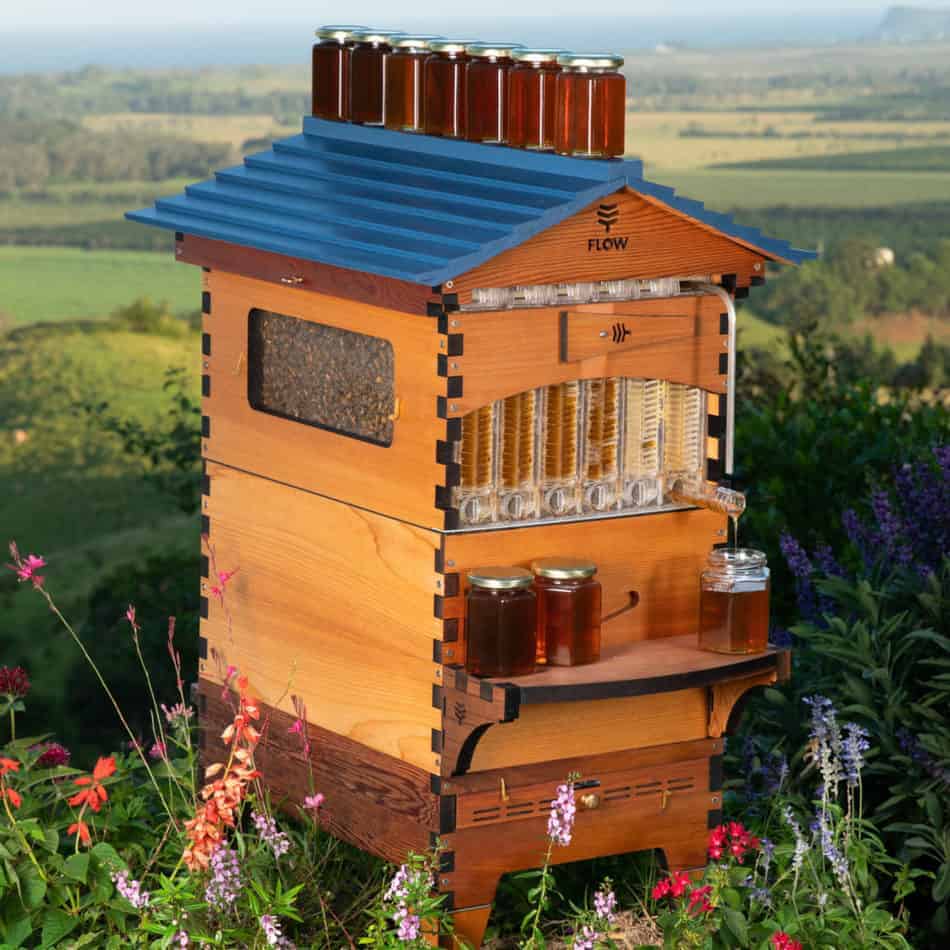
I don’t recommend mixing and matching different woods between your bee boxes, covers, and bottoms. Just stick with one wood type for each hive.
⚠️ DO NOT use pressure treated wood, MDF, or plywood for your bee boxes. You don’t want chemicals, or carcinogenic glues and binding agents to be passed into your honey.
Standard Dimensions Of Beehives
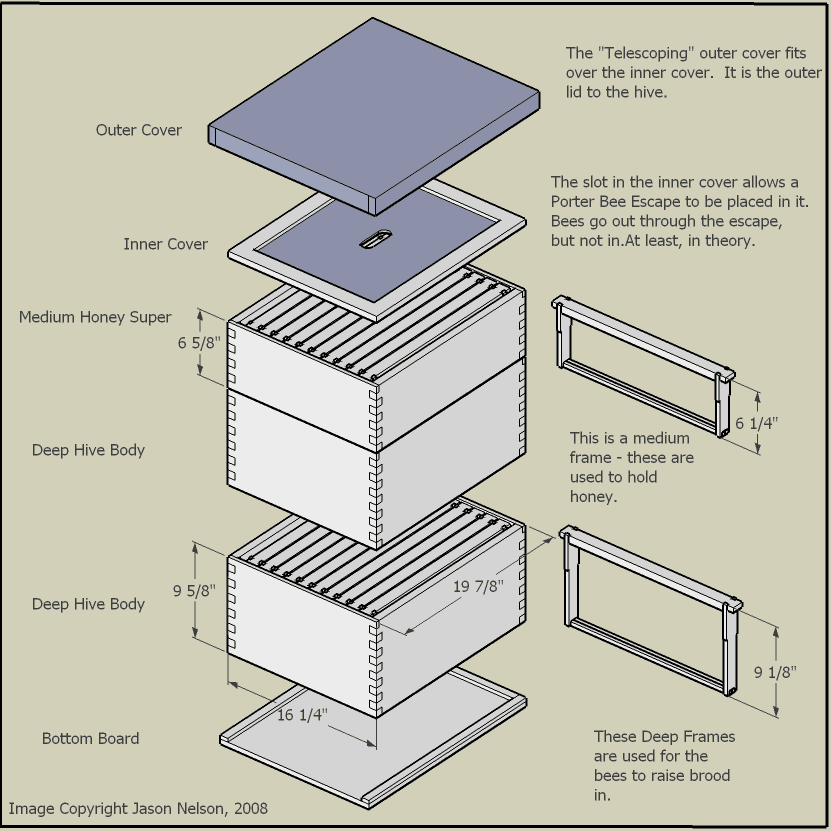
The two most popular bee boxes are the 10 frame brood and the 10 frame medium super. The medium supers are popular because they are more light weight than the deep body boxes and more common with hobbyists.
Deep body boxes are more common in larger bee operations since they can hold more honey, between 80-100 lbs.
See the chart below for standard dimensions of 10 frame beehives.
| Standard 10 Frame Box | Length | Width | Height |
|---|---|---|---|
| Deep Body – Brood Box | 19 7/8″ | 16 1/4″ | 9 5/8″ |
| Medium (Illinois) Super | 19 7/8″ | 16 1/4″ | 6 5/8″ |
| Shallow Super | 19 7/8″ | 16 1/4″ | 5 3/4″ |
| Comb Super (extra shallow) | 19 7/8″ | 16 1/4″ | 4 3/4″ |

Some beekeepers prefer 8 frame boxes over the standard 10 frames. The biggest reason is they’re lighter to move around and a bit cheaper to buy.
Other beekeepers believe that 8 frame boxes outperform 10 frame hives for honey production. Although, I was unable to locate any study proving this assumption.
There are several disadvantages of 8 frame boxes:
- You handle more boxes during the honey flow
- You end up with higher or significantly more hive stacks – especially in commercial operations.
- It’s difficult to find specialized equipment such as pollen traps and top feeders to fit 8 frame boxes.
Don’t intermix 8 frames with 10 frames since they are not compatible. Just pick one and go with it. See the chart below for standard dimensions of 8 frame beehives.
| Standard 8 Frame Box | Length | Width | Height |
|---|---|---|---|
| Deep Body – Brood Box | 19 7/8″ | 13 3/4″ | 9 5/8″ |
| Medium (Illinois) Super | 19 7/8″ | 13 3/4″ | 6 5/8″ |
| Shallow Super | 19 7/8″ | 13 3/4″ | 5 3/4″ |
| Comb Super (extra shallow) | 19 7/8″ | 13 3/4″ | 4 3/4″ |

I’ve also included a chart below for the standard dimensions on 5 frame NUC’s:
| Standard 5 Frame NUC | Length | Width | Height |
|---|---|---|---|
| Deep Body – Brood Box | 19 7/8″ | 9 1/4″ | 9 5/8″ |
| Medium (Illinois) Super | 19 7/8″ | 9 1/4″ | 6 5/8″ |
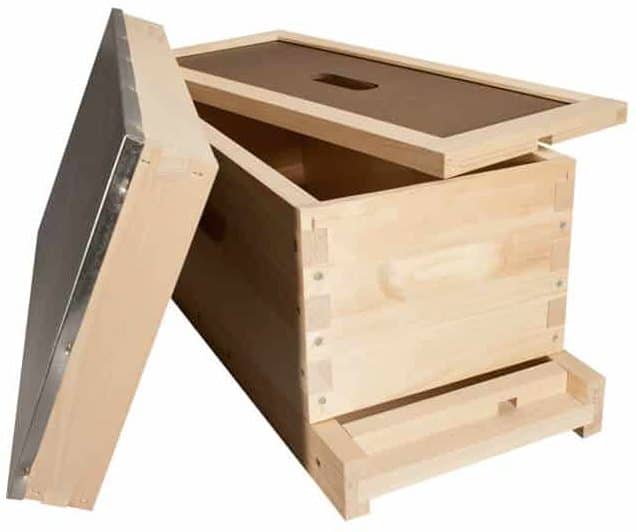
How Much Do Bee Boxes Cost
There are many online and local suppliers that sell bee boxes. I’ve researched several of the most popular online retailers to get an average cost of bee boxes.
See the chart below for the cost of Pine, Cyprus and Cedar 10 Frame Medium Supers and Deep Brooder Bee Boxes.
There is a price range for the Pine boxes depending on the grade of wood selected. All prices are in US dollars.
10 Frame Box, Cover’s and Bottom Board Prices
| Pine | Medium’s | Deep’s |
|---|---|---|
| Unassembled | $13-$18 | $15.50-$23 |
| Assembled | $17-$20 | $20.50-$26 |
| Cover | $12.95 | $12.95 |
| Cover + Painted | $14.45 | $14.45 |
| Inner Cover | $13.85 | $13.85 |
| Bottom Board – Solid | $16.95 | $16.95 |
| Bottom Board – Solid + Painted | $22.61 | $22.61 |
| Cypress | Medium’s | Deep’s |
|---|---|---|
| Unassembled | $18.00 | $22.00 |
| Assembled | $23.00 | $27.00 |
| Assembled + Painted | $33.00 | $37.00 |
| Cover | $20.00 | $20.00 |
| Cover + Painted | $25.00 | $25.00 |
| Inner Cover | $12.00 | $12.00 |
| Bottom Board – Solid | $20.00 | $20.00 |
| Bottom Board – Solid + Painted | $25.00 | $25.00 |
| Cedar | Medium’s | Deep’s |
|---|---|---|
| Unassembled | $40.00 | $54.00 |
| Assembled | $48.00 | $64.00 |
| Assembled + Sealed | $53.00 | $69.00 |
| Cover | $46.00 | $46.00 |
| Cover + Sealed | $50.00 | $50.00 |
| Inner Cover | $32.00 | $32.00 |
| Bottom Board – Solid | $64.00 | $64.00 |
| Bottom Board – Solid + Sealed | $69.00 | $69.00 |
I also researched the average price for 10 frame Medium Super’s and 10 frame Deep Brooder Box Kits. They all included 10 wooden frames with wax foundation applied, but no cover or bottom board.
See the chart below for the cost of Pine (only premium wood selected) and Cyprus wood. All prices are in US dollars.
10 Frame Box Kits – Frames & Wax Foundation Included
| Premium Pine | Medium’s | Deep’s |
|---|---|---|
| Unassembled | $44.95 | $49.95 |
| Assembled | $55.40 | $63.75 |
| Assembled + Painted | $56.95 | $61.95 |
| Cypress | Medium’s | Deep’s |
|---|---|---|
| Unassembled | $43.50 | $50.50 |
| Assembled | $53.50 | $63.00 |
| Assembled + Painted | $63.50 | $73.00 |
As you can see by the chart above, the price of Cypress bee box kits is comparable to Premium Pine. But when purchasing on a larger scale Pine is still preferable.
See the chart below for the average cost of 5 frame NUC’s in Pine and Cypress. All prices are in US dollars.
5 Frame NUC’s, Covers and Bottom Board Prices
| Pine | Medium’s | Deep’s |
|---|---|---|
| Unassembled | $15.75 | $15.75 |
| Assembled | $17.90 | $18.95 |
| Cover | $9.95 | $9.95 |
| Inner Cover | $8.95 | $8.95 |
| Bottom Board – Solid | $13.25 | $13.25 |
| Cypress | Medium’s | Deep’s |
|---|---|---|
| Unassembled | $14 | $16 |
| Assembled | $19 | $21 |
| Assembled + Painted | $29 | $31 |
| Cover | $15 | $15 |
| Cover + Painted | $20 | $20 |
| Inner Cover | $9 | $9 |
| Bottom Board – Solid | $13 | $13 |
| Bottom Board – Solid + Painted | $18 | $18 |
I also researched the average price for 5 frame Nucleus Hive Kits. They include the cover and bottom but no frames.
See the chart below for the cost of Pine (only premium wood selected) and Cyprus wood. All prices are in US dollars.
5 Frame NUC Hive Kits – Cover & Bottom Included
| Premium Pine | Medium’s | Deep’s |
|---|---|---|
| Unassembled | $36.95 | $41.95 |
| Assembled | $56.95 | $57.95 |
| Cypress | Medium’s | Deep’s |
|---|---|---|
| Unassembled | $54.75 | $56.25 |
| Assembled | $62.25 | $67.00 |
| Assembled + Painted | $82.25 | $87.00 |
Related Questions
What is the best paint for beehives? The best paint for beehives is a water-based latex paint, rated for exterior use with low levels of VOC’s (volatile organic compounds). The VOC’s should be under 100 but ideally you want 50 or lower. This will protect your beehive against the elements while ensuring the safety of your bees.
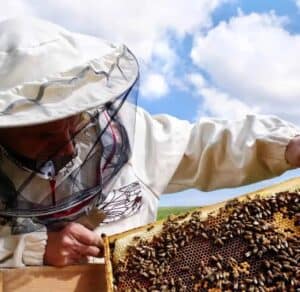
Joseph Davis
My goal is to show that anyone can take up beekeeping and it can be a very rewarding hobby. I strive to share my experiences and answer any questions you may have.
